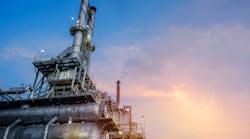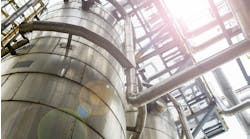Fired heaters provide important heating requirements for process streams that must be heated to high temperatures, or to support reactions occurring in these heaters. By operating these furnaces more efficiently, you save energy in terms of natural gas and emissions. This column will discuss some factors to lower energy bills by improving the heater’s efficiency.
I often visit refineries where heaters are not operated efficiently. This is partly because the refinery generates significant off-gas, which must be consumed or go to the flare system. Although I agree the flare system should never be used to burn off-gasses, rarely this is true. The off-gasses from plants like hydrotreaters, fluid catalytic cracking units and delayed coker units are directed into the fuel gas system.
Imported natural gas (at a cost) or propane (which can be sold as a product) supplement these off-gasses. This fuel gas also contains a large percentage of hydrogen, a waste gas from a hydrogen production unit, a naphtha reformer, a hydrocracker, and the aforementioned hydrotreater units. Hydrogen production is expensive, so recovering hydrogen from these units should be maximized to minimize the concentration in the fuel gas while offloading the hydrogen production plant.
Gaining Efficiency
Reducing the amount of fuel gas fired in a heater will decrease the amount of natural gas imported. This is where the efficiency gains must be made. For instance, the heater burns fuel gas supplemented with oxygen from air. This air, which is about 80% nitrogen, is heated in the burners. Then, it is cooled in the heater radiant and convection section. Heating and then cooling this air results in inefficient heating. The most efficient heater uses the least amount of air while maximizing fuel gas combustion. Full combustion of the fuel gas can be determined by measuring how much CO is produced. I recommend placing a CO analyzer in the heater stack to ensure continuous full combustion.
I often visit refineries where heaters are not operated efficiently.
To minimize CO formation in the flue gas, adding extra air ensures these heaters fully combust the fuel gas. This excess air should be controlled between 10% and 15% of the total airflow and measured by the concentration of O2 in the stack. For a properly operated heater, this value ranges between 1.5% and 2.0% vol% of O2. Typically, CO levels are from 10 to 50 ppm vol%, with the alarm setting at 100 ppm.
Another parameter to consider is the furnace draft. Draft is “negative pressure” and normally expressed in mmH2O. Any location in the heater should have a negative pressure (therefore a positive draft). The draft at the burner level will support the airflow into the burner plenum box. Then, the gradient of the draft will ensure the flue gas is directed upward into the stack. The draft value is smallest at the heater’s bridge wall, which is situated between the radiant section and the convection section of the furnace’s main roof. This draft should always be positive (negative pressure), and a proper operating pressure measured at the bridge wall should fall between 2 and 3 mmH2O. A water gauge measures this draft at the side of the heater; modern heaters have pressure transmitters for control room readouts.
A few controls are available to manage these parameters (oxygen and draft). Most heaters contain a damper in the stack that can gradually open or close to control the bridge wall pressure. The air can be set by registers controlling the airflow into the plenum box at each burner. Sometimes the heater has a forced draft air system with an inlet damper that controls airflow. The following steps optimize the heater efficiency:
- Check the flame patterns, O2, CO and draft at the bridge wall.
- Reduce the stack damper opening by 5% if the draft or O2 is high, or CO is low.
- Increase the stack damper opening by 5% if the draft is low.
- Examine each air register and its flame pattern if the O2 is low or the CO is high. Long, lazy yellow flames may indicate oxygen deprivation, requiring the air register to be opened by 5% more.
- Close the register by 5% if the flame is nearly invisible, blue-ish and very short.
- Continue with 1 until all conditions are satisfied.
Long-Term Efficiency
To further optimize heater efficiency, you can consider a few long-term projects, for instance, increasing the heat recovery from the stack gas, or an air preheat system if the stack temperature exceeds 360–400°F. However, with today’s drive toward net zero emissions, other options should be considered, such as electric furnaces, hydrogen firing and oxyfuel, as recovering CO2 from the flue gases may prove expensive and inefficient. In future columns, I will discuss these new technologies in more detail.



